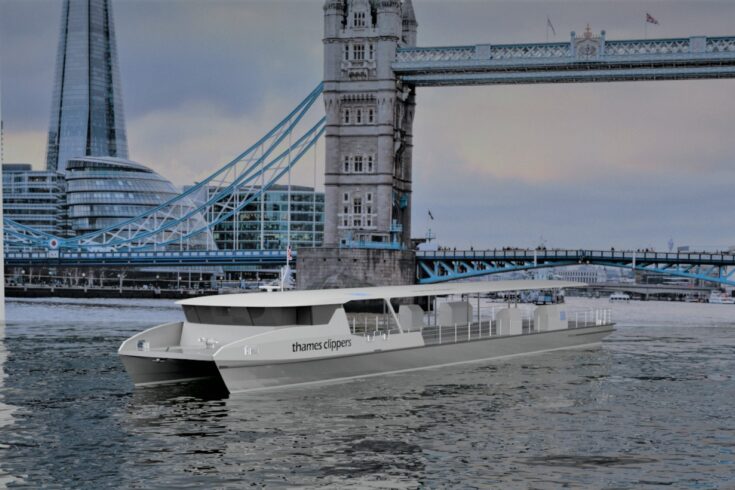High-speed vessel operator Thames Clippers are heading up a new project that will offer a solution to remove freight from London’s roads and onto the River Thames.
Congestion in the capital is increasing as home deliveries continue to grow, along with the rising emissions this creates. It’s never been more important to help resolve the problem of transport in London.
Although the river provides a route in and out of central London, current shipping services are yet to offer a truly viable alternative for businesses and customers. Finding a river freight service that is faster, more reliable and with less carbon emissions, has the potential to make a real impact.
Zero emission fast freight
The Zero Emission Fast Freight (ZAFF) project is looking to take a tailor-made vessel and hull design. It will then demonstrate an efficient and viable electric-powered freight journey that has not yet been seen for faster vessels in domestic river settings.
The project will use high-density, marinised battery technology, alongside innovative 2 megawatt (MW) fast-charging infrastructure that will support faster, greener and more reliable journey turnaround and scheduling for the vessels.
The project seeks to validate the performance and efficiency opportunity of using battery power. Also, to showcase the emissions and wider environmental benefits of removing diesel heavy goods vehicles from overcrowded London roads and suburban settings. It will also look to help unlock the wider uptake of electric river freight in the UK.
The project scope
The project is headed by Thames Clippers, along with specialists in Wight Shipyard, charging experts Aqua superPower, the Port of London Authority and engineering consultants Beckett Rankine.
Under the project, a specifically designed 40 metre, 100% electric catamaran will operate along a 14.6 nautical mile route from Dartford to Tower Bridge Quay in central London. This will demonstrate the ability of the vehicle to offer a new solution to outer-to-inner London transport issues.
The vehicle will be capable of travel at 22 knots along the 55 minute journey, with the potential to transport up to 54,000 middle-mile parcels a day between the two locations. With each freight load being the equivalent of up to 20 commercial vehicles on the roads.
To facilitate the journeys, fast-charging infrastructure will be constructed at either ends of the route. Using novel battery technology and equipment, the project will incorporate accurate recharging and freight unloading times to ensure a dependable and predictable timetable can be maintained for the vessel.
Aims and ambitions
The ZAFF project aims to create one of the first domestic green shipping corridors in the UK. There will be three journeys a day into London, as well as return journeys that have the potential to take further goods out of the city. The project aims to turn an unpredictable 70 to 120 minute journey by road into a far more consistent 55 to 60 minute river route.
By using a repurposed hull design and architecture tailored to this specific use case and location. The project is looking to achieve valuable data and learnings into the optimal ways to make larger vessels travel further and faster, while carrying the largest payload possible.
It will also help in the development of charging solution concepts by the creation of a 2MW fast-charging floating barge. The ambition with this is to power the vessel back to 80% charge in just 30 minutes. These insights will then help build similar use cases for other potential docking points along the river in future.
Away from the infrastructure itself, the project partners will collaborate to help develop new regulatory approvals that are required to unlock the commercial use of electric vessels on inland waterways.
Further studies will also be commissioned into quayside impact and emissions savings. Work will also be done to achieve planning consents to facilitate the wider use of the vessels and charging points for the future.
The potential for the project in such a major city is huge, believes Geoff Symonds, Chief Operating Officer at Thames Clippers:
In a recent annual traffic study, London was ranked the world’s slowest city by road, so, with eCommerce and delivery continually increasing, it’s becoming harder to get goods into London in an efficient way.
There is a real opportunity to revitalise the Thames as a transport artery for the city, and the test and demonstration of our freight vessel is the first step towards scaling up net zero river logistics to support this aim.
About the funding
This project is part of the Zero Emission Vessels and Infrastructure (ZEVI) scheme, funded by the UK government and delivered by Innovate UK.
As part of ZEVI, the UK Department for Transport has allocated £80.4 million funding to 10 projects. The funding will build clean maritime vessel and infrastructure solutions by March 2025 and operate them until March 2028. The projects are supported by 52 organisations across the UK and will leverage over £40 million private investment.
The ZEVI scheme is part of the Department of Transport’s UK Shipping Office for Reducing Emissions programme, a £206 million initiative. It is focused on developing the technology necessary to decarbonise the UK domestic maritime sector.
Top image: Thames Clipper passing under Tower Bridge London. Credit: Thames Clippers

